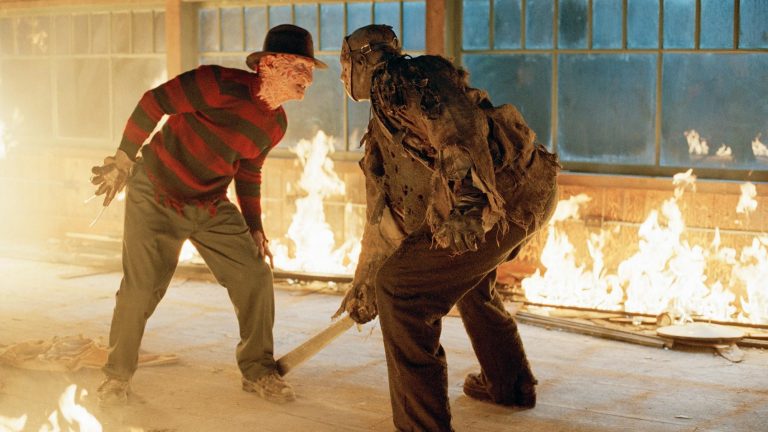Why Freddy vs. Jason Is the Most Faithful Nightmare on Elm Street Sequel
Freddy vs. Jason tried to make Freddy scary again.

Freddy Krueger has a choice to make. On one side is Lori (Monica Keena), the woman he had been antagonizing throughout the movie Freddy vs. Jason, along with her wounded boyfriend Will (Jason Ritter). On the other is Kia (Kelly Rowland), Lori’s grouchy friend.
After dithering for a moment, Freddy (Robert Englund) looks at the Kia and smiles. “How sweet,” he says to the Black woman. “Dark meat.”
Remembering seeing the movie when it was released 20 years ago, Kumail Nanjiani described the audience’s groans at that line. “People were disappointed in Freddy Krueger,” Nanjiani recalled. “We’re okay with you murdering children with your needle gloves,” he quipped. “But racism?”
Nanjiani’s bit captures the public perception of Freddy when Freddy vs Jason premiered on August 15, 2003. Even though the character officially died in 1991’s Freddy’s Dead: The Final Nightmare, the terrifying monster of Wes Craven’s 1984 film A Nightmare on Elm Street had already experienced a more ignoble death, descending to a hell of 80s kitsch. The general audience thought of him not as a child murderer who mocked the suffering of teens, but as a lovable creep with dad jokes.
As unprepared as fans might have been for Freddy’s racism (strangely, nothing is said about Kia’s homophobic slur that follows), Freddy vs. Jason at least brought the dream demon back to his roots, reminding viewers that he is, fundamentally, a child-murdering dream demon.
Freddy’s History of Violence
The son of a repressive fundamentalist mother, Wes Craven used horror to attack the assumptions of the conservative mainstream. For his debut The Last House on the Left, Craven reimagined Ingmar Bergman’s The Virgin Spring for a world without God, letting the father of a raped and murdered girl go on a nihilistic rampage without the revelation experienced by the father in the Ingmar Bergman original. In The Hills Have Eyes, an all-American family on vacation falls prey to mutant cannibals, themselves the byproduct of nuclear bomb tests.
In A Nightmare on Elm Street, Craven turned his attention to the hypocrisy of white flight, making suburbia into a death trap of their own making. In their attempt to protect their children, the parents of Elm Street gave Freddy even more power, effectively dooming their kids. Nothing captures that point better than when Nancy (Heather Langenkamp) tries to escape her house to evade Freddy and instead discovers that she’s locked inside.
To ramp up the danger to the children, Craven imagined Freddy as an incredibly nasty figure of surreal menace. In the 1984 original, Freddy’s taunts are less comic and more inexplicable, as when he struts down an alleyway with his arms overextended, creating sparks as his claws scrape the side, or cuts off his finger and sneers, “This is your god.” Instead of entertaining the audience, Freddy’s jokes showed his victims just how powerless they were in the dream world he dominated.
Freddy’s Nightmare: Becoming a Cheesy TV Host
That didn’t last long. When Craven returned to the franchise to co-write 1987’s A Nightmare on Elm Street III: The Dream Warriors, he inadvertently cheapened his greatest creation. The Dream Warriors applied the Aliens principle to Freddy, letting his victims gain powers to fight back in the dream world. It was an exciting approach, but it also reimagined his victims as would-be warriors who could fight back at any time.
At the same time, Freddy grew in popularity and New Line Cinema took advantage of the marketing opportunities. In 1987, Freddy followed the footsteps of the Teenage Mutant Ninja Turtles and Hulk Hogan by releasing his own pop record, Freddy’s Greatest Hits. For an exorbitant fee, fans could call a telephone number and play a trivia game, which Englund himself hocked in a corny tv spot. In 1988, Freddy hit his nadir, embracing his inner Crypt Keeper to become the sanitized and goofy host of the anthology series Freddy’s Nightmares.
None of these developments made Freddy any less murderous on screen. 1988’s A Nightmare on Elm Street 4: The Dream Master contains some of the most iconic and upsetting scenes in the series, including Debbie’s roach motel death and the soul pizza sequence. But the movie also includes Freddy pretending to be a shark and donning shades, a foretaste of the devolution that would lead to him wearing a Nintendo Power Glove and boasting, “Now, I’m playing with power.”
Freddy vs. Jason vs. Good Taste
Craven knew that his creation had lost its way, and worked to restore the evil to Freddy. When he wrote and directed 1994’s Wes Craven’s New Nightmare, Craven created a postmodern story that posited the existence of a Dream Demon who took the form of Freddy. When Englund, Langenkamp, and Craven — all portraying themselves — allowed Freddy to become an unserious joke, the Demon began to torture them, hoping to restore our fear.
Freddy vs. Jason had no such lofty intentions. Now that New Line had the rights to Jason Voorhees, the studio could finally bring to the screen a clash of the 80s titans. After going through several drafts, including one by Star Trek greats Ronald D. Moore and Brannon Braga, the studio finally settled on a solid story from newcomers Mark Swift and Damian Shannon. Although the duo overstates Jason’s fear of water (the guy rode a boat to New York!), Swift and Shannon perfectly capture the state of a nation no longer scared of Freddy.
“Being dead wasn’t a problem, but being forgotten, now that’s a bitch,” says Freddy in the film’s opening narration. “I can’t come back if nobody remembers me. I can’t come back if nobody’s afraid.”
Within the movie, Freddy comes back by unleashing Jason (Kenneth Kirzinger) on a new generation of Elm Street kids, hoping that he’ll be blamed for the murders and gain the power to return. But on a meta level, Swift and Shannon and director Ronny Yu restore our fear of Freddy by giving us a version of the monster we haven’t seen in years.
During the opening narration, the camera pans over to show a whimpering little girl, watching in fear as Freddy creates the razor glove he’ll use to murder her. Later, when taunting Lori, Freddy adds a sexual menace to his attacks not seen since the bathtub attack in the original Nightmare, running his blades slowly up her inner thigh. Freddy even manages to make the lumbering Jason somewhat sympathetic by taking the form of his mother Pamela (Paula Shaw) and mocking her son’s failures. Later, when Jason reverts to a swim-trunk-clad child, shivering and crying, Freddy stands over the boy and takes pleasure in his vulnerability.
Freddy Lives On in Our Nightmares
Freddy vs. Jason wasn’t completely successful in rehabilitating Freddy’s impotent image. Even beyond Yu’s slick direction, which emphasized kinetic fight scenes instead of well-staged kills, the movie had plenty of lame jokes and moments of goofiness, such as when Freddy becomes a giant worm to possess stoner Freeburg (Kyle Labine). In the 2010 remake A Nightmare on Elm Street tried to further up the nastiness of Freddy, following Craven’s original idea by making Krueger into a pedophile in addition to a murderer. But as with Freddy vs. Jason, the cruelty in the script was undermined by flashy direction, this time from music video director Samuel Bayer.
Despite these shortcomings, Freddy vs. Jason succeeded in taking Freddy back to his roots, reminding us what made him such an amazing monster in the first place.
